Organic grape and wine farming: Thanks to the support from all of our Hydeout Sonoma vineyard clients, we are a 100% organic farming operation. As this debate continues, I invite you to take an in-depth look at the differences between conventional and organic. Let’s start with some revealing imagery:
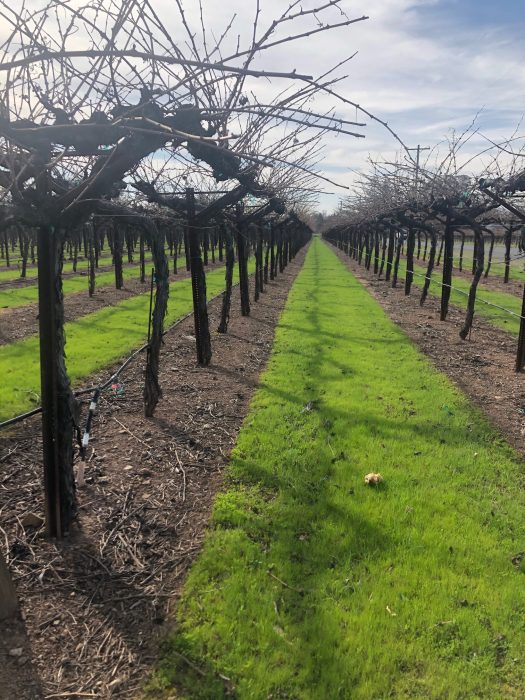
This is what a vineyard floor looks like when it’s been sprayed with Roundup. Note the complete absence of problematic weeds, nothing to compete with the vine’s roots, squeaky clean, nothing will grow on this bare dirt except the grapevines. This is a good thing if you want to assure that your grapevines aren’t competing for nutrients and water.
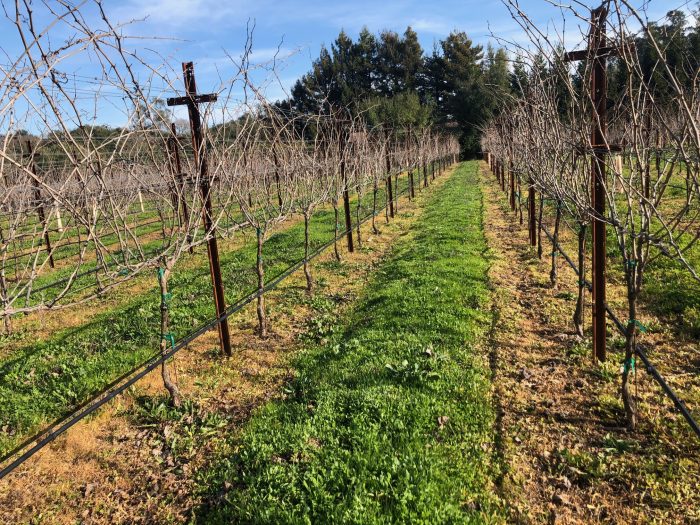
Take a look at the organic farming approach – in this case using the Weed Slayer. Note the absence of most problematic weeds growing under the vine rows. You will also notice the soil under the vine rows roughly almost the same result as Roundup.
Next, let’s debate the topic: with Roundup, one spray pass in the vineyard and every weed is gone for the season. In terms of cost effectiveness and the near-absolute eradication of weeds competing with the vines for water and nutrients, Roundup is the clear winner. However, Roundup seemingly kills most soil born microbes and beneficial insects. With an organic approach like Weed Slayer, the material for each application is about 2X-3X more expensive, and multiple passes are often needed, because the product doesn’t ‘knock down’ the weeds quite as well, and so in total it costs a little to a lot more for the same level of effectiveness as Roundup. But, it is organic.
If you were the farmer, what option would you choose? With Roundup, there is an alleged risk to health. The health risk is presumably much lower using the organic product. But, the organic option will add substantially to the labor and spray costs of your crop. How do you choose to compete?
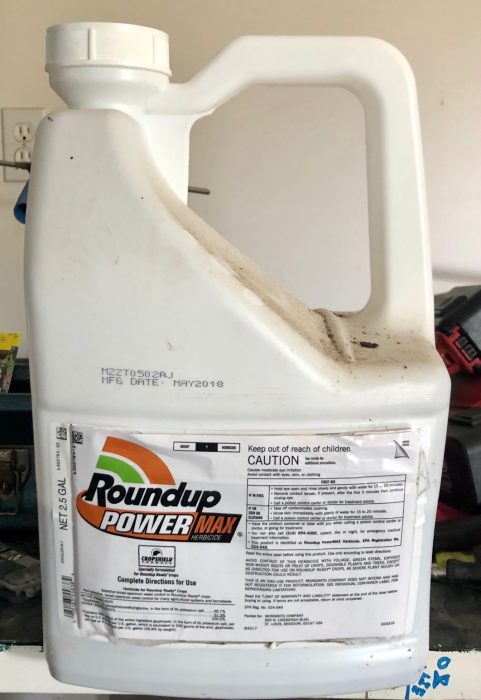
Roundup is a Glyphosate and comes with a standard “Caution” warning. It is thought to be particularly dangerous to honey bees.
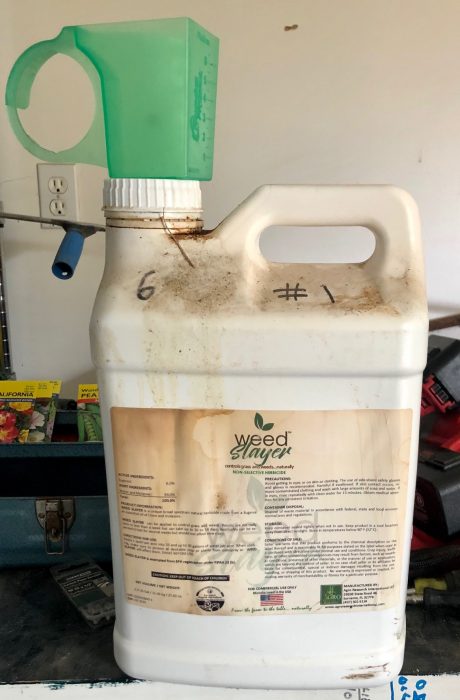
Weed Slayer consists of two separate products (Parts A & B) that you mix together to make one exceedingly effective weed killer. Part A is the Weed Slayer, a broad spectrum herbicide crafted from Eugenol (an essential oil from cloves) and molasses. Part B is Agro Gold, a biological adjuvant containing Streptomyces and Bacillus microbes. The Eugenol and molasses in Part A will make its way down to and kill the roots and/or root ball of the undesired plant. The soil enhancing bacteria in Part B clears the way for and drives the Eugenol down into the roots. This action allows Weed Slayer to kill the whole plant quickly, including the root system, making it more effective than “burndown herbicides” for ongoing weed control.
Winter soup, chickens, eggs, and raised beds:
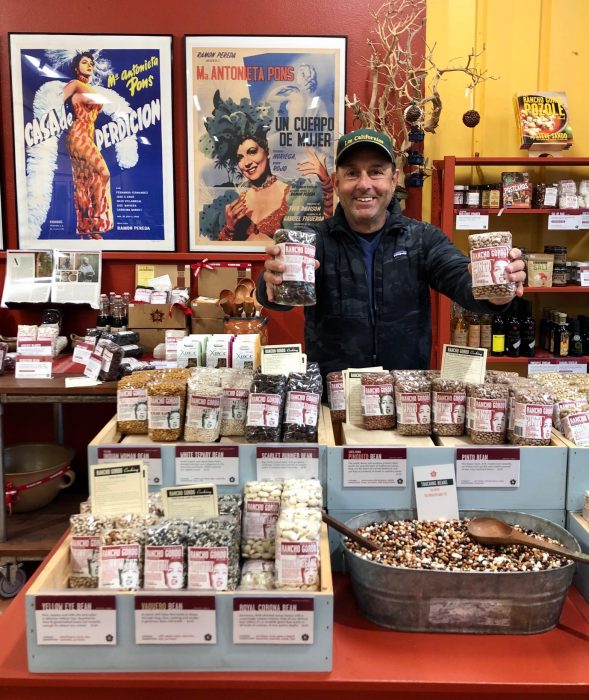
One of our favorite weekend stops for supplies to make a delicious pot of soup on cold winter nights; nothing beats Napa’s “Ranch Gordo” beans, a super high quality company with typical and unusual bean varieties. And lots of other products and great recipes. Really lovely people too! See this link: Rancho Gordo specialty foods and heirloom beans
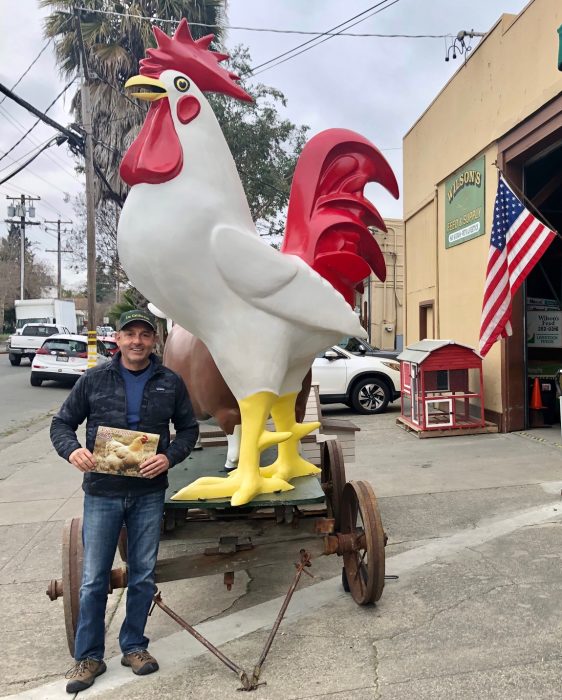
Wilson’s Feed and Supply in Napa is a great choice for all kinds of chicken and animal supplies. We’ve purchased over a dozen baby chicks here and the results have been excellent: https://www.facebook.com/WilsonsfeedandSupplyLLC/

A happy Valentine…sun-glassed Cynthia Wornick displays eggs from our expert chicken neighbors next door, Lori and Steve Bush of Gremlin Farms. And just this week our own Dysfunctional Family chickens began laying too.

Hydeout Sonoma’s winter garden is pushing onions, kale, potatoes, carrots, and beans; all will be ready to harvest in early spring. The Dysfunctional Family chickens pretty much mowed down the broccoli (4th raised bed from the left), so their ‘free range’ was slightly curtailed while the garden is in action! We’ll plant the summer crops soon – tomatoes, basil, lettuce, and so on. (I started the willow trees in the background from cuttings and they’ve grown to 20 feet in 4 short years).
Violins of Hope
The Nazis used music and especially violins to humiliate and degrade Jews in ghettos and in concentration camps. They confiscated many thousands of instruments from Jews all over Europe. Camp victims were forced to ‘play for their supper’ as the Nazi’s gorged on their meals while camp victims were forced to play music while slowly starving.
After the liberation many of these violins, some recovered with human ashes inside, were sent to Israel where they were lovingly re-built. And now they are on a new life-affirming journey where these instruments are once again being heard by audiences. The Violins of Hope concerts are the ultimate survivor’s reply to the Nazi’s plan to annihilate a people and their culture, and to destroy human lives and freedom.
My parents, Anita and Ronald C Wornick, underwrote a Violins of Hope event in San Francisco last week. I am of course very proud of my parent’s continued resilience on this topic as they lost many family members during the war, in camps, in the Ponar forest (near Vilna, home to many of my ancestors), and they continue to this day to raise awareness and celebrate our family heritage…
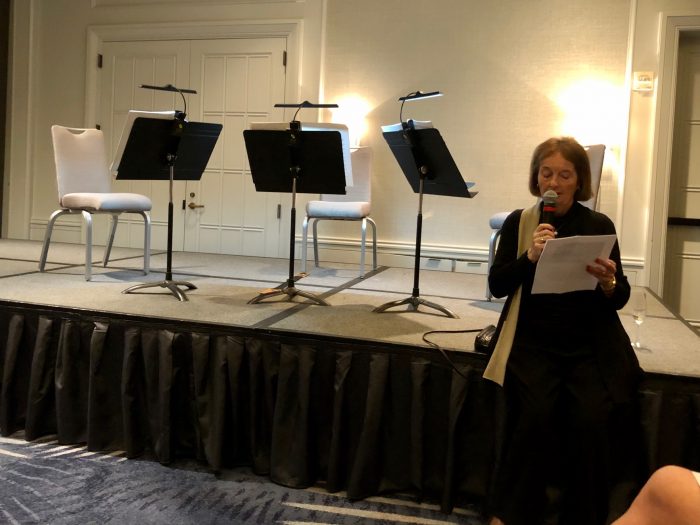
This is my adorable mom Anita who at 83 years old is as vibrant and fun as ever. My dad, Ron, at 87, was sitting in the audience with our children and brothers, leaving it to our Mom to make the introductions.
Please watch this brief video of 3 “Violins of Hope.” These 3 talented SF symphony musicians are playing 3 of the actual recovered and rebuilt instruments (2 violins and 1 viola): Brief “Violins of Hope” video from San Francisco
Want to know more about who rebuilt these instruments? Click here: Amnon Weinstein – repairer of violins
Artisan furniture master woodworker Stine Poole
Stine Poole, is a close family friend who operates a noted wood and furniture studio in San Diego. Stine sources wood from all over the world including from his noteworthy High Valley Ranch in Montana Stine’s studio can be found here: Stine Poole – Furniture by Design. If you have reason to commission a special piece of furniture to fit an exact need, please contact Stine. He would be delighted to hear from you. Following here are few images of some current work in progress. Click on the website to see more images. Stine Poole – Furniture by Design
Full Moon Hike to Bald Mountain
Our constantly evolving group of local hikers routinely depart just before sunset to climb Bald Mountain inside the Sugarloaf Ridge State Park in Sonoma, arriving at the top just as the full moon rises over St Helena and the Napa Valley. We climb approximately 1,500 feet in 2.5 miles, pause to watch the full moon rise, share some great snacks, pass around Tequilla shots, and head down hill under the light of that full moon.
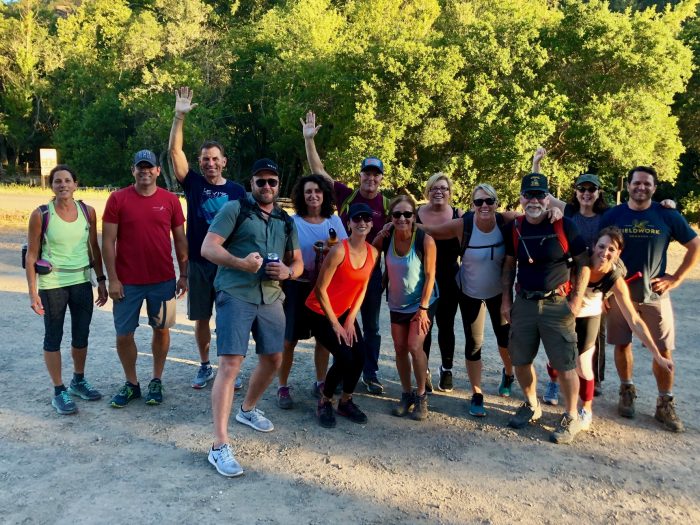
On this particular Full Moon hike, a large group from EA’s Crossfit joined in: EA’s Crossfit Gym in Sonoma

We’ve reached the 2,729 foot summit just as the sun sets and the full moon is about to rise. Looking south from the summit in Sonoma is the Napa Valley, Vallejo, and the Bay.
The Sonoma Valley Museum of Art “Summer Solstice” Party
After six years on the board of the Sonoma Valley Museum of Art, I will be terming out. But I’ll still be around for more museum fun…in this case the museum hosts an ongoing series of events called “Great Places, Great Spaces.” Along with our neighbors Steve and Lori Bush of Gremlin Farms, we will be hosting a progressive event, drinks and apps at Hydeout Sonoma and dinner at Gremlin Farms. Please join us. Click on this link for tickets to our event: Great Places Great Spaces at Hydeout Sonoma and Gremlin Farms

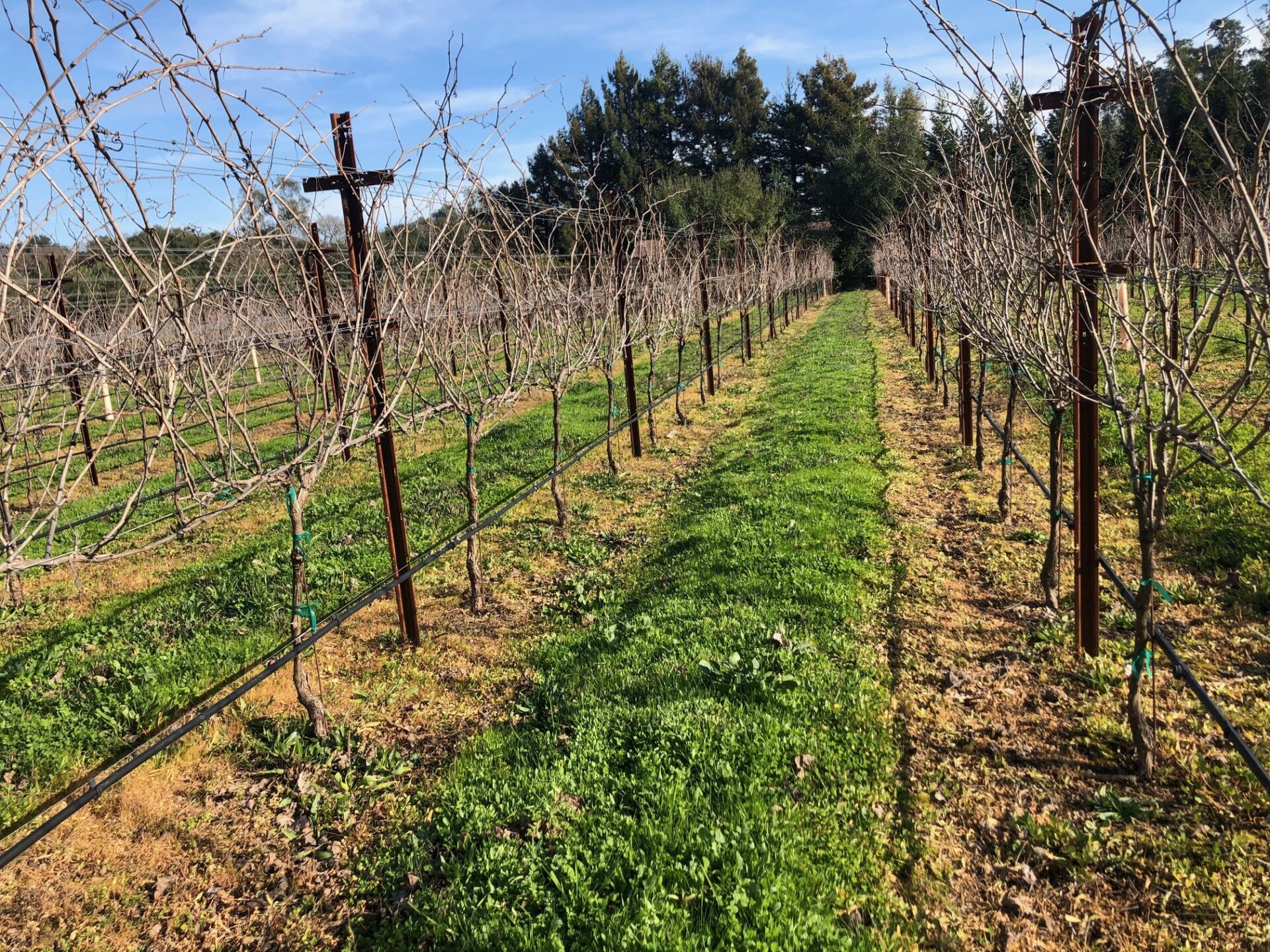

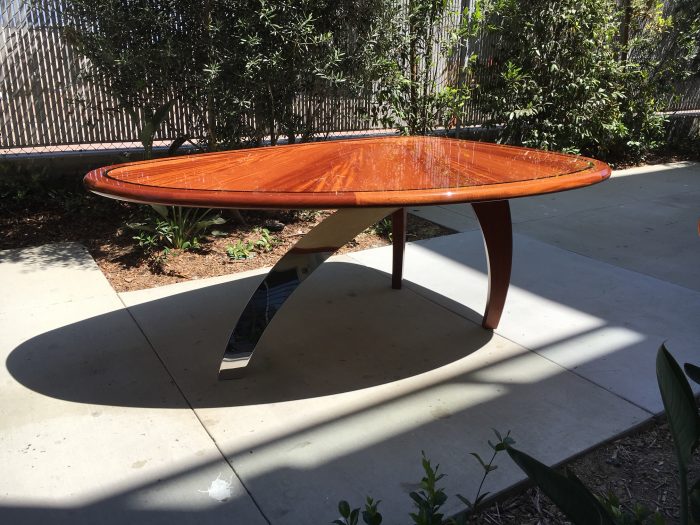




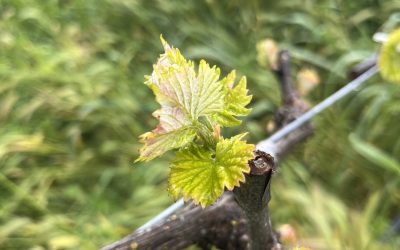

I had relatives in MA who planted willow trees and they indicated they did not share resources well with others. What do you think about willow trees?
Indeed, Willow trees are voracious feeders. They will consume all water within reach. They have to be planted very carefully, well away from gas lines, electrical conduit, irrigation lines, concrete decks and so. They will tear all the stuff up. But they are very fast growers (with a short lifespan). If you plant them well away from human-made improvements, they will offer shade to animals, food and nesting habitat for birds, and as they age out, new trees (oak and pine) will start to grow under them – eventually you’ve recovered a desolate landscape into something verdant and healthy!
One more thing – Willows have a very effective growth hormone in their bark. Cut up a bunch of smaller Willow branches and soak them in water – and presto you have a supply of rooting hormone for any other plants. Try pouting the solution on tomato starters…bang, instant growth!
Great comments, loved reading it. Very interesting, keep it going, wish I could still hike, guess that is over.
Thank you very much Simon. It’s amazing what you can find just on a slow walk on the sidewalk at dusk around Sonoma town. I took a walk along the Arroyo Seco creek a few nights ago – saw owls, hawks, deer, rabbits; and found an injured Red Tail Hawk – gathered it up carefully and took it to the Bird Rescue Center on Chanate Raod in Santa Rosa. https://www.birdrescuecenter.org Wonderful team of docs and nurses carefully examined it and likely it will be released at our ranch in a couple of weeks!
I want fresh eggs and am willing to drive from Marin!
4-6 dozen per week starting in June, I think you’d make an excellent fresh egg farm stand salesperson!
Organic VS Conventional – when my neighbours spray, you see bees at my hives “fried”… they walk around ruined. The studies show as much as a 40% increase in some cancers, from applying even one use of Round-up. The EU has banned this class for many years as they cannot prove it is safe and many high-quality studies prove it is highly toxic. Workers health, the wine you drink holding these toxins – imagine the tonnage required in this county and what it must do as it passes through our soil into our water table. Organic promotes biodiversity in the soil and the plant life surrounding the vines VS a virtual desert for pollinators. Other well used organic methods include planting symbiotic flowers along with the root system and cover crops amongst the rows further stimulating an improving the soil. This 3$ billion industry thrives by killing us the standard should not be on the individual to prove something legally sold is killing us, the standard should rest with the purveyors to prove it is safe first. We require this with cars and yet allow the seeds of our kid’s foods to be soaked in Round-Up… smart of you to hold to this 100% standard. Thanks, farmer. PS – keep an eye out for ranch/farm sales and any garage sale at a ranch, the chicken equipment for sale is always so much better than the modern and mostly plastic stuff. NIck
Couldn’t agree more. Helpful to have your expertise and commentary re honey bees. There is a lot we don’t know about this. But why not be conservative and eliminate chemicals where possible? At my scale, 2-5 acre vineyards, it’s somewhat affordable and definitely sensible to be organic. In the 25-500 acre farming challenge, they’ll have to find ways to reduce and eventually stop using Roundup. There might be one minor defense for using Roundup – when an area of ground has been scraped, cleared, or manipulated in some – for example an old heavily-trod horse pasture (like at our ranch) – huge numbers of invasive weeds rush to take over. To give the native grasses a chance to repopulate, some VERY small amount of careful spot spraying of Roundup (on the individual weed leaves) seems like a good way to overcome invasive weeds and encourage native plant growth. Thoughts?